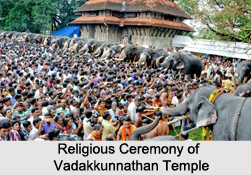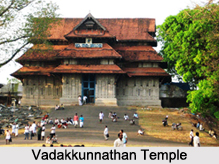 Vadakkunnathan Temple in Trichur is one of the most unique, ancient and important of the sacred shrines of Kerala. It stands on a beautiful hillock at the centre of Trichur overlooking the town. The vast maidan around the temple is called Tekkinkadu or forest of teak woods and Trichur town literally revolves round the temple.
Vadakkunnathan Temple in Trichur is one of the most unique, ancient and important of the sacred shrines of Kerala. It stands on a beautiful hillock at the centre of Trichur overlooking the town. The vast maidan around the temple is called Tekkinkadu or forest of teak woods and Trichur town literally revolves round the temple.
Legend of Vadakkunnathan Temple
There is a legend behind the three main deities which are believed to have been installed by Parasurama. The story goes that first he prayed to Lord Shiva that he should manifest Himself there. But when he opened his eyes what he saw was the image of the four-armed Mahavishnu with the conch, the disc, the mace and the lotus. This is now worshipped as Lord Rama. (In fact in Kerala almost all important Krishna temples including the famous Guruvayur temple whether worshipped as Lord Rama or Lord Krishna have the image of Mahavishnu in the form of Viswaroopa in which the lord appeared before Devaki and Vasudeva at the time of His birth.)
Not satisfied with the manifestation of Mahavishnu, Parasurama continued his meditation. This time a small Shivalinga materialised to the north of Lord Vishnu. Parasurama was surprised to see Shiva on one, side and Rama on the other side. He again went into meditation. Opening his eyes he saw in the middle of the two deities, Sankaranarayana, the combined form of Shiva and Vishnu or Narayana. He was now satisfied and realised that Shiva and Vishnu are in fact one and the same.
Thus there are three main shrines in the temple, dedicated to Shiva, Vishnu and Sankaranarayana. Behind Shiva, the goddess Parvati was also installed by Parasurama. This image is of wood and hence no abhisheka is performed for this deity. All other idols are of stone except that of Vadakkunnathan which is a mound of ghee. This is again a unique feature of the temple.
Deity of Vadakkunnathan Temple
Traditionally the abhisheka to Parameswara here is always with cow`s ghee. Because of this constant abhisheka the ghee will be seen to form a mound as it were. The Maha-linga cannot be seen because it is covered with ghee. The mound is nearly 10 feet around the original linga and there is hardly any space for the priest to go around in the small sanctum. That in spite of so many lamps burning in the sanctum or even in hot weather the ghee does not melt nor any worm or bad smell occurs in the accumulated ghee is a matter for wonder.
In the Ayurveda, old ghee is prescribed as cure for many diseases. Only at Trichur temple there is ghee which is as old as a thousand years. Hence, the Vaidyas in Kerala are known to approach this temple for old ghee.
 There is one more idol, of Vettakkorumakan, supposed to be the guardian of the temple at the northern nalambalam. These are all the deities installed in the inner precincts of the temple.
There is one more idol, of Vettakkorumakan, supposed to be the guardian of the temple at the northern nalambalam. These are all the deities installed in the inner precincts of the temple.
Outside, at a distance from the temple, all round, is the pradakshina vaihi (circumambulatory path) which has a uniform width of seven feet. A few minor deities or upadevatas stand along this path.
Architecture of Vadakkunnathan Temple
The massive stone wall enclosing an area of nearly 9 acres and forming a strong fortification and the four lofty gopurams overtopping the central shrine and indicating the four directions-North, South, East and West -and above all the dozens of peepal trees scattered on the vast grounds of the temple gives Vadakkunnathan temple a unique and magnificent appearance.
In the centre of this vast enclosure on a level ground is a multi-shrined complex having three principal shrines dedicated to Shiva or Vadakkunnathan, Sankaranarayana and Rama. The Vadakkunnathan is on the northern side, a circular structure, the deity facing west. The figure of Shiva-Parvati is facing east and just back to Shiva, situated in the same shrine. At the southern end is located the two-storeyed shrine of Lord Rama also facing west. Between these two srikoils stands a third one, circular and double-storied in shape, dedicated to Sankeranarayana and it also faces west. This shrine has beautiful murals of the seventeenth century delineating graphically the story of Mahabharata. There are mukhamandapams in front of all the three central shrines.
Worship in the Vadakkunnathan Temple
The temple opens at three in the morning and closes about 10.30 after the morning rites. For the evening worship it opens at four and closes at 8.30 at night after `Trippuka`, the last rite for the day. It is a pleasing feature of the times and this temple especially that hundreds of men and women flock to the temple for darshan from the early hours of the morning after taking their bath at all seasons of the year.
Festivals in the Vadakkunnathan Temple
There are no annual utsavams or other celebrations here except Shivaratri. And the Lord never comes out of his abode. Even during the Shivaratri celebration, which is the most important ceremony of this temple, the deity is not taken out in procession. During the famous Pooram festival celebrated annually in Medam (April-May), Lord Vadak-kunnathan is but a mere spectator granting the premises and convenience for the festival. No offering is received or any expenditure is incurred by this temple in connection with the Pooram festival. Not even any special pooja is offered on the occasion though the Thekkinkadu maidan is the venue of the festival.











